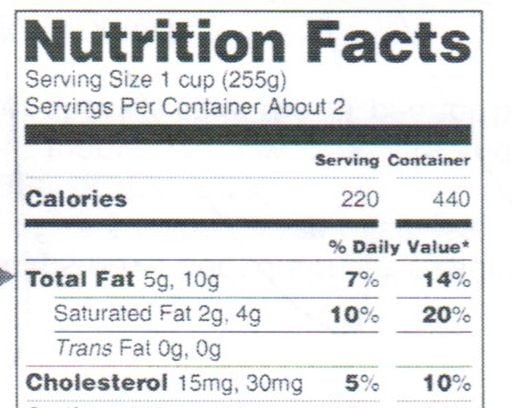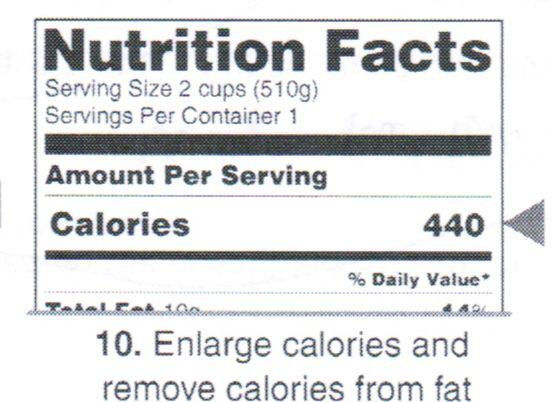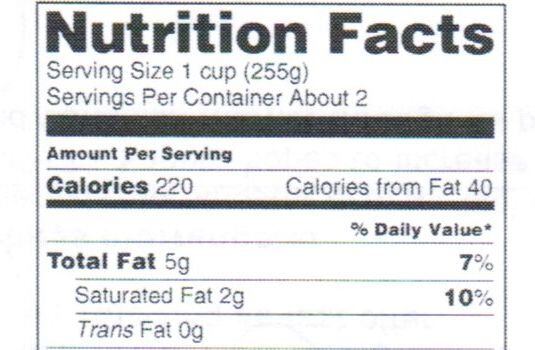According to new research, you are not alone.
In more than 9,000 online interviews, Amy Lando MPP and Serena Lo PhD from the FDA’s Center for Food Safety and Applied Nutrition, asked consumers to compare new formats for Nutrition Facts labels on products that contain two servings but are customarily consumed in one go.
The FDA-funded research, published in the Journal of the Academy of Nutrition and Dietetics, revealed that spelling out how many calories are in the whole container/package helped shoppers trying to make healthier choices at a glance.

New formats tested included a dual-format label listing calories per serving and per container, and a simpler label that just lists the serving size as one container, so shoppers can see at a glance how many calories they will consume if they eat such products in one sitting, say the authors.
“We found that on products that contain two servings but arecustomarily consumed at a single eating occasion, using a singleserving per container or a dual-column labeling approach may help consumers make healthier food choices.”
Regardless of their math skills, doing calculations on food labels was not a priority
The findings echo recent research from focus groups (eg. Lando & Labiner-Wolfe, 2007) which found that participants “repeatedly expressed displeasure with labels that listed two servings per container for products that they thought they would eat in a single eating occasion”, said the authors.
“Regardless of their math skills, many stated that doing calculations on food labels was not an interest or priority.”
Other researchers (Antonuk and Block, 2006) have also reported that people typically eat less of a multiple-serving snack food when it is labeled with a dual-column versus a single-column format, they note.
“Dual columns may act as a contextual cue to highlight the number of servings per container and the amount consumed if the entire package is eaten and, hence, reduce consumption.”
So what conclusions did they draw from their own research?
“Labeling a food as having one serving per container instead of two caused participants to rate the products as being less healthful, whereas dual-column labeling did not have this effect”, they observed.
“Thus, if one of the goals of improving nutrition labeling is to emphasize the relative healthfulness of various foods and perhaps decrease the rate at which individuals exceed their daily calorie needs, then labeling foods customarily consumed in a single eating occasion as a single serving may be more effective than dual-column labeling.”
Marion Nestle: It would be much better if the Nutrition Facts panel could be simplified

Asked to comment on their findings, Marion Nestle, professor in the department of nutrition, food studies and public health at New York University, told FoodNavigator-USA:
“This must be the first piece from the FDA’s announced research plan to revise the food label. As usual, they presented a bunch of choices—10 models, 4 outcome measures--which makes the results hard to follow. I’ll take the results at face value.
“But most food products with multiple servings, even those that might be consumed at one sitting (a 20oz soda, for example) have more than two. How would the multiple format deal with that situation? “
She added: “What’s interesting is how hard it is to figure out a clear label. Way back when the FDA first started work on Nutrition Facts, it did the same thing as it’s doing now—presenting far too many options. Then, nobody understood them very well. The FDA picked the least worst. Now, the FDA is just asking about calories.
“It would be much better if the Nutrition Facts panel could be simplified. Why isn’t the FDA following the advice of the two IOM committees it sponsored? IOM’s version of traffic lights made a lot of sense.”
Adam Drewnowski, PhD, Professeur Associé at the Université Pierre et Marie Curie - Paris VII, said: "I totally agree [with the paper's conclusions]. "Having calories per container as well as per serving may be the best option."
But he added: "Calories per container is fine if you are dealing with a bottled beverage or a bag of potato chips. But what do you do with a box of cereal which clearly contains multiple servings? Or a big bag of nuts?"
Which products say they contain 2 servings - but are typically eaten all in one go?

Under current regulations, manufacturers have some discretion for determining serving sizes for packaged foods that contain more than one serving but are reasonably consumed in a single eating occasion.
Key examples include 20oz sodas and grab bags of chips, where serving size amounts are based on reference amounts customarily consumed (RACC) and are defined for a variety of food categories.
For example, a soda bottle containing 480 ml (16 floz) may be labeled as one serving if it can be reasonably consumed in a single eating occasion, but otherwise must be labeled as containing two or more servings.
The Nutrition Facts panel
In 2005, the Food & Drug Administration (FDA) issued two Advance Notices of Proposed Rulemaking requesting comments on format changes to the Nutrition Facts label.
One sought comments on whether to give greater emphasis to calories, including by removing the term ‘calories from fat’ and the other requested comments on serving size regulations.
Click here to read more about what changes academics, health lobbyists and food manufacturers would like to see made to the Nutrition Facts panel.
Source: Journal Of The Academy Of Nutrition And Dietetics , 2013;113:241-250.
Title: “Single-Larger-Portion-Size and Dual-Column Nutrition Labeling May Help Consumers Make More Healthful Food Choices”
Authors: Amy M. Lando, MPP; Serena C. Lo, PhD
